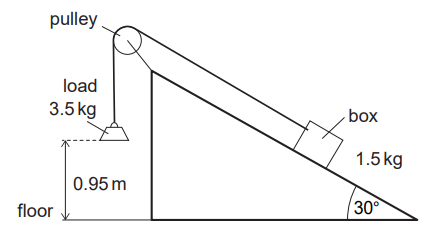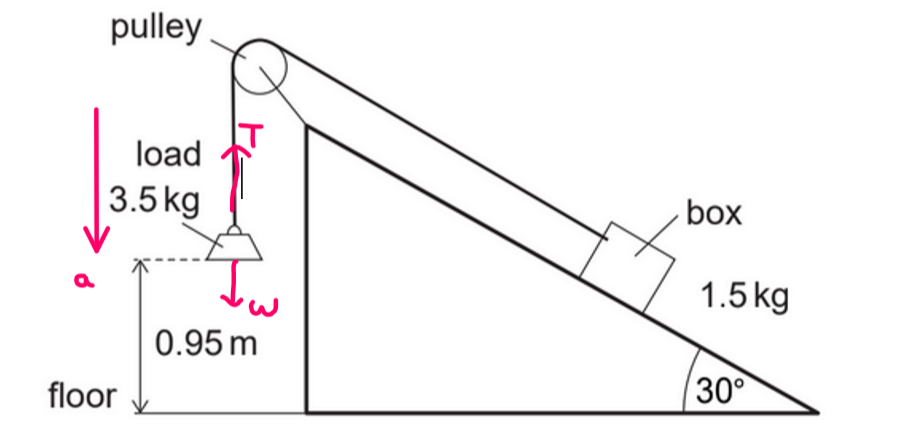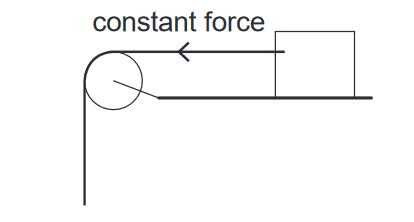Q.1(a).2022-May-Physics_paper_2__TZ1_SL
Topic: Forces
Given: A student uses a load to pull a box up a ramp inclined at 30°. The string passes over a pulley that runs on a frictionless axle. Friction acts between the base of the box and the ramp. Air resistance is negligible.

The load has a mass of 3.5kg and is initially 0.95m above the floor, mass of the box is 1.5kg, load is released and accelerates downwards.
Calculate: Outline two differences between the momentum of the box and the momentum of the load at the same instant.
Answer/Explanation
Solution:
The momentum of the box and the momentum of the load are different for two reasons:
Direction: At the same instant, the momentum of the box will be in the upward direction, while the momentum of the load will be in the downward direction. This is because the box is moving up the ramp due to the force of friction acting in the opposite direction to the motion of the load.
Magnitude: The momentum of the box and the load will be different in magnitude because the mass and velocity of the two objects are different. The load has a greater mass than the box, so it will have a greater momentum at the same velocity. Additionally, because the load is accelerating downward due to gravity, its velocity is increasing, which means that its momentum is also increasing over time. The box, on the other hand, is moving at a constant velocity, so its momentum remains constant.
Q.1(b).2022-May-Physics_paper_2__TZ1_SL
Topic: Forces
Given: vertical acceleration of the load downwards is $2.4 \mathrm{~m} \mathrm{~s}^{-2}$
Calculate: the tension in the string?
Answer/Explanation
Solution:

Writing $F=ma$ for load,
$W-T=m(a)$
$3.5(g)-T=3.5\times 2.4 $
$g=9.8m/s^{-2}$
| $T=25.9 ~N$ |
Q.1[(c) (i)].2022-May-Physics_paper_2__TZ1_SL
Topic: Forces
Given: a=($2.4 m/s^2$) , s=0.95 m , u=0 m/s (initially at rest)
Prove: the speed of the load when it hits the floor is about 2.1 m/s
Answer/Explanation
Solution:
we can use the kinematic equation:
$v^2 = u^2 + 2as$
where:
v = final velocity (unknown)
u = initial velocity (0 m/s)
a = acceleration ($2.4 m/s^2$)
s = distance traveled (0.95 m)
Plugging in the given values, we get:
$v^2 = 0^2 + 2(2.4)(0.95)$
$v^2 = 4.56$
Taking the square root of both sides, we get:
$v = \sqrt{4.56}$
$v \approx 2.134\ m/s$
So, the speed of the load just before hitting the ground is approximately 2.134 m/s.
| $v=2.1 m/s$ |
Q.1[(c) (ii)].2022-May-Physics_paper_2__TZ1_SL
Topic: Forces
Given: The radius of the pulley is $2.5 \mathrm{~cm}$. Calculate the angular speed of rotation of the pulley as the load hits the floor.
State: your answer to an appropriate number of significant figures.
Answer/Explanation
Solution:
We can use the formula $\omega=\frac{v}{r}$ to relate the speed $v$ of the load to the angular speed $\omega$ of the pulley, where $r$ is the radius of the pulley. Substituting the given values, we have:
$\omega=\frac{v}{r}=\frac{2.1\text{ m/s}}{0.025\text{ m}}=84\text{ rad/s}$
Rounding to 2 significant figures gives an answer of $\omega = 84 \text{ rad/s}$.
Q.1(d).2022-May-Physics_paper_2__TZ1_SL
Topic: Forces
Given: After the load has hit the floor, the box travels a further 0.35 m along the ramp before coming to rest. Determine
Calculate: the average frictional force between the box and the surface of the ramp.
Answer/Explanation
Solution:
Energy equation for block=
$
\frac{1}{2} m v^2=F_{n e t} \cdot s
$
$
\mathrm{m}=1.5 \mathrm{~kg}
$
$v=2.1 \mathrm{~m} / \mathrm{s}$ from (c)
$\mathrm{s}=0.35 \mathrm{~m}$ for the block .
$
\frac{1}{2} \times 1.5 \times(2.1)^2=F_{\text {net }} \times 0.35
$
$\begin{aligned} & F_{n e t}=9.45 \mathrm{~N} \\ & \text { Weight down ramp }=1.5 \times 9.8 \times \sin (30)=7.4 \mathrm{~N} \\ & \text { friction force }=\text { net force }-\text { weight down ramp }=2.1 \mathrm{~N} \end{aligned}$
| $f=2.1~N$ |
Q.1(e).2022-May-Physics_paper_2__TZ1_SL
Topic: Forces
Given: student then makes the ramp horizontal and applies a constant horizontal force to the box. The force is just large enough to start the box moving. The force continues to be applied after the box begins to move.

Explain: with reference to the frictional force acting, why the box accelerates once it has started to move.
Answer/Explanation
Solution:
$\Rightarrow $ static coefficient of friction > dynamic/kinetic coefficient of friction $( μ_s > μ_k )$
$\Rightarrow $ force of dynamic/kinetic friction will be less than the force of static friction
$\Rightarrow $ there will be a net / unbalanced forward force once in motion which results in acceleration .
Q.2(a).2022-May-Physics_paper_2__TZ1_SL
Topic: Thermal concepts
Given: mass of $55 \mathrm{~g}$ of milk enters the sterilizing unit every second and flows over an electrical heating element.
The temperature of the milk is raised from $11^{\circ} \mathrm{C}$ to $84^{\circ} \mathrm{C}$.
Specific heat capacity of milk $=3.9 \mathrm{~kJ} \mathrm{~kg}^{-1} \mathrm{~K}^{-1}$
Calculate: the power input to the heating element(in appropriate unit)
Answer/Explanation
Solution:
$\text{mass}=55\times 10^{-3}$
$\Delta T=(84-11)=73~K$
$c=3.9 \mathrm{~kJ} \mathrm{~kg}^{-1} \mathrm{~K}^{-1}$
$\text{Power}=\frac{\text{Energy}}{\text{time}}$
$P=\frac{\mathrm{m\cdot c\cdot \Delta T}}{\text{1 sec}}$
substitute all the values in formula ,
| $P=15.658 kJ$ |